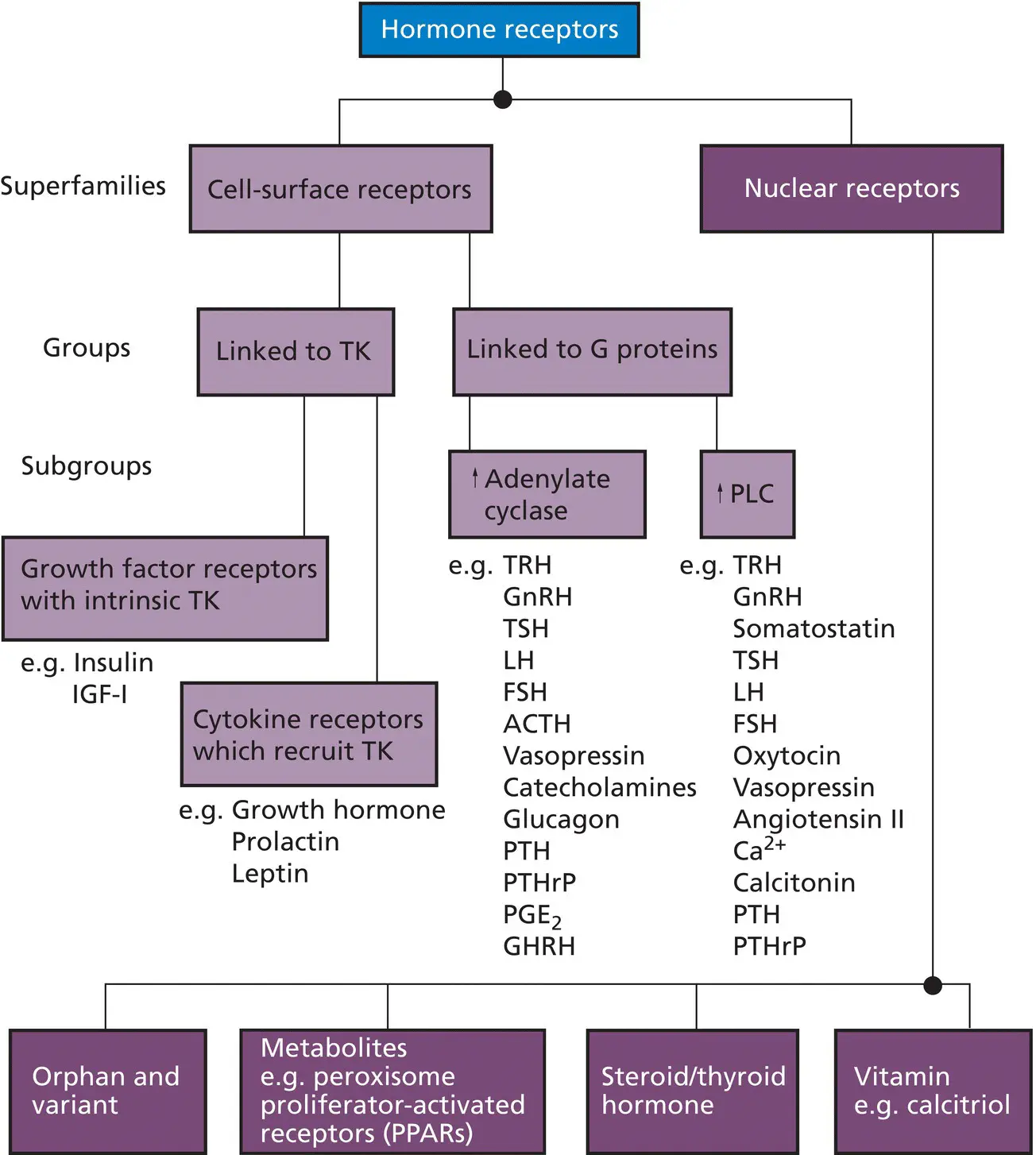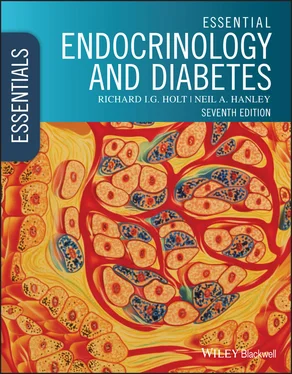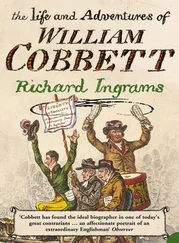Nomenclature of steroidogenic pathways
Figure 2.6shows an overview of steroid hormone biosynthesis in human. Many of the enzymes that catalyze steps in these pathways are encoded by the cytochrome P450 ( CYP ) family of related genes that is also critical for hepatic detoxification of xenobiotic compounds and drugs. Some of the enzymes are common to both the adrenal cortex and gonad (e.g. CYP11A1), whereas others are restricted and explain the distinct steroid profiles in each tissue (e.g. CYP21A2, needed for cortisol and aldosterone biosynthesis, is very largely limited to the adrenal cortex).
Historically, the enzymes have been named according to function at a specific carbon atom (e.g. hydroxylation), with a Greek letter indicating orientation above or below the four‐carbon ring structure (e.g. 17α‐hydroxylase attaches a hydroxyl group in the alpha position to carbon 17; Figure 2.6).
The common names used for steroids also adhere to a loose convention. The suffix ‐ol indicates an important hydroxyl group, as at the carbon‐3 position in cholester ol. T he suffix ‐one indicates an important ketone group (testoster one ). The extra presence of ‐di, as in ‐diol (oestra diol ) or ‐dione (androstene dione ), reflects two of the groups. ‘‐ene’ (androst ene dione) indicates an important double bond in the steroid ring structure.
Storage of steroid hormones
In contrast to peptide hormones, which are stored and capable of rapid release, steroid hormones are synthesized on demand. This delays their release into the circulation following an initial stimulus explaining, at least in part, the slower onset of action for steroid hormones compared to peptide hormones.
Most peptide hormones are hydrophilic and can circulate free in the bloodstream with little or no association with serum proteins. In contrast, steroid hormones and thyroid hormones are hydrophobic and circulate largely bound to proteins. There are relatively specific transport proteins for many of the steroid hormones, e.g. cortisol‐binding globulin (CBG) and sex hormone‐binding globulin (SHBG), as well as for thyroid hormones [thyroxine‐binding globulin (TBG)]. These hormones also associate more loosely with other circulating proteins, especially albumin. The amounts of protein‐bound and unbound (‘free’) hormone are in equilibrium in the circulation. Only the free hormone can diffuse readily into tissues and act on target cells. Many clinical assays still measure total hormone in blood and are consequently affected markedly by changes in the concentration of the binding protein. This can be misleading because shifts in the equilibrium mean that free hormone concentrations are relatively constant and biological activity remains the same. For instance, women on the combined oral contraceptive pill have raised serum CBG and increased total cortisol. However, free cortisol levels and cortisol action is unaltered.
 Key points
Key points
Mutations in DNA and chromosomal abnormalities can cause endocrine disease
Meiosis is central to reproductive endocrinology
Peptides and proteins are encoded by genes, which are stretches of genomic DNA
Many protein hormones are synthesized as prohormones, which require post‐translational modification and processing before they become active
Enzyme cascades synthesize hormones derived from amino acids and cholesterol
Unlike peptide hormones, steroid hormones are not stored in cells but made on demand
Many peptide hormones circulate free in the blood, unlike steroid or thyroid hormones, which associate with binding proteins
CHAPTER 3 Molecular basis of hormone action
Key topics
Cell‐surface receptors
Tyrosine kinase receptors
G‐protein–coupled receptors
Nuclear receptors
Key points
To understand the principles of hormone–receptor interaction
To know the different classes of hormone receptors and how they functionTyrosine kinase receptors and their signalling pathwaysG‐protein–coupled receptors and their signalling pathwaysNuclear receptors and how they regulate gene expression
To appreciate the role of transcription factors that are important in endocrine development and function
To appreciate how abnormalities in hormone receptors or their downstream signalling can cause endocrinopathy
This chapter describes the key events that occur within the cell following stimulation by hormone
Hormones act by binding to receptors. There are two superfamilies of hormone receptor: the cell‐surface receptors and the nuclear receptors, named according to their site of action. Both classes display characteristic features ( Figure 3.1and Box 3.1).
Cell‐surface receptors comprise three basic components ( Figure 3.2). Signalling through the receptors is initiated by binding of the hormone to the receptor followed by signal transduction.
Binding of hormone to receptor
Historical experiments used radiolabelled hormones and isolated preparations of receptors to define two properties of binding ( Box 3.2). The hormone–receptor interaction is both saturable ( Figure 3.3) and reversible ( Figure 3.4).
Using methodology similar to that for immunoassays ( Chapter 4), constant amounts of labelled hormone and receptor preparations can be incubated with increasing, known amounts of unlabelled hormone for a specified time. Separating and measuring the receptor‐bound, labelled fraction allows curves to be plotted and mathematical modelling of the hormone (H)–receptor (R) interaction; e.g. whether it conforms to the equation H + R ⇆ HR. These types of experiment can also allow estimation of the number of hormone receptors present on each target cell.
When a hormone binds to a cell‐surface receptor, two major types of signalling cascade unfold inside the cell; protein phosphorylation by kinase enzymes or the generation of ‘second messengers’ via coupling to guanine (‘G’) proteins. Signalling through either process amplifies the hormone response as many protein phosphorylation events or second messenger molecules are produced for each hormone–receptor interaction. These two types of signalling pathway divide the cell‐surface receptor superfamily into two subclasses: tyrosine kinase receptors and G‐protein–coupled receptors (GPCRs) ( Figure 3.1and Box 3.3).

Figure 3.1 The different classes of hormone receptor. Some cell‐surface receptors, e.g. the parathyroid hormone (PTH) receptor, can link to different G‐proteins, which couple to either adenylate cyclase or phospholipase C (PLC). TK, tyrosine kinase; TRH, thyrotrophin‐releasing hormone; GnRH, gonadotrophin‐releasing hormone; TSH, thyroid‐stimulating hormone; LH, luteinizing hormone; FSH, follicle‐stimulating hormone; ACTH, adrenocorticotrophic hormone; PTHrP, parathyroid hormone‐related peptide; PGE 2, prostaglandin E 2; GHRH, growth hormone‐releasing hormone; IGF‐I, insulin‐like growth factor I.
Box 3.1Some basic facts about hormone receptors
Tissue distribution of receptor dictates the scope of hormone action:The thyroid‐stimulating hormone (TSH) receptor is expressed almost exclusively in the thyroid, therefore TSH action is largely restricted to the thyroidThyroid hormone receptor expression is widespread and therefore thyroid hormone action is diverse
Читать дальше

 Key points
Key points











